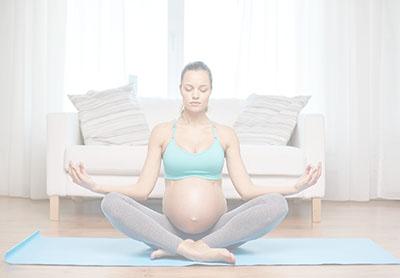As you’ve likely heard by now, pregnancy is beautiful, exciting and magical... but it’s also incredibly stressful. Doctors appointments, shopping for baby supplies, getting the nursery together, and planning for maternity leave start to add up. Being pregnant can take a toll on your mental well-being as well as your physical health. One of the most effective ways to keep stress at bay and re-center yourself is through meditation. By setting aside just a few minutes of your day to be silent, focus on your breathing, and let go of all your thoughts, you’ll feel refreshed, rejuvenated, and ready to tackle that never-ending to do list.
Even if you weren’t a regular meditator before, it’s an important wellness habit that can work wonders on your physical and mental health. With a growing belly, sore back and swollen feet, pregnancy meditation requires a few tweaks to be successful. But with these 7 key pointers, you’ll be on your way to a peaceful, more relaxed (and more comfortable) pregnancy. Plus, you’ll feel more connected to your baby than ever.
1. Find a Comfortable Position

Whether you’re a veteran meditator or a newbie, you’ll notice that your growing belly can make it tough to get comfortable and even tougher to focus on your breathing. Most meditation is best done while sitting upright, but that’s not always possible, especially when you’re in your third trimester. While those ‘rules’ are more like guidelines, don’t stress too much about how you used to sit or lie down pre-pregnancy, just find a position that’s comfortable for you and most importantly, that doesn’t give you any discomfort or pain. Lying down is a great option, especially on your side with a pillow propped in between your legs. As part of your pre-meditation ritual, try using Mustela Stretch Marks Oil as a way to soothe your skin, protect against future stretch marks and relax with its calming scent.
2. Focus on Your Belly

As your belly continues to expand, you can tailor your meditation to focus on the growing little one inside of you. Try a deep belly breathing technique, where you place your hands on your bump and hold your baby. Really tune into what’s happening inside of your belly, and notice if you feel any warmth or movement. Breathe slowly, in and out, and breathe deeply into your belly. Start with five minutes a day, and work to increase your time each week.
3. Breathe Deeply
Although some meditation techniques require fast breathing, such as bellows breath (breathing in and out as quickly as possible through your nose), these methods aren’t always an option when you’re pregnant. It’s already easy to lose your breath when you’re pregnant, and these techniques can actually make you more dizzy and lightheaded.
Instead, focus on breathing in deeply. Start with your eyes closed, and breathe through your nose. Slow down your normal breathing, and continue with long deep breaths until your belly expands followed by your rib cage and then your chest. Exhale in reverse, emptying your chest, ribcage, and then your belly (you can breathe out through your nose or mouth, whichever feels more relaxing and comfortable). In the later months, you’ll notice less movement in your abdomen as you breathe in and out, but try to visualize the air entering you and filling your belly like it did pre-pregnancy.
4. Pick a Mantra

Not all meditation requires finding and repeating a mantra, but some people swear by these techniques for their calming and inspirational capabilities. When you repeat a phrase over and over during meditation, it permeates your self-conscious, and allows you to truly absorb the words’ powerful meaning. During pregnancy, try selecting a mantra that fills your need at the time. For strength, try “Adi Shakti,” which means power of the feminine. To let go of anxiety and live in the moment, chant “I am, I am,” which allows you to exist in the present and let go of future worries.
5. Try Guided Pregnancy Meditation
Meditation is a powerful practice that can transform your energy and stress levels, but sometimes it can be difficult to do on your own. Especially if you’re new to meditation, you might not have the tools to totally let go of distractions for a few solid minutes. This is where guided meditation comes in.
Find a local yoga or meditation studio you can visit to meditate under the guidance of a trained instructor. It’s even better if the studio offers prenatal meditation classes. If not, be sure to inform the teacher that you’re expecting, and that you might need to make required adjustments. If a local meditation class isn’t a possibility, download a guided meditation app to meditate in the comfort of your own home.
6. Check With Your Doctor
Although meditation has few negative side effects and almost always provides nothing but valuable health benefits, make sure you mention your meditation plans to your OBGYN. Your doctor will want to make sure it’s safe and healthy for you, and he or she might have some insightful tips to help you along the rest of your pregnancy. Also be sure to tell your midwife, doula, or anyone else who will be attending your birth that you’ve been meditating. Meditation tends to have an impact on labor, and expectant mothers who meditate may want to incorporate the techniques they’ve been practicing into their actual birth.
7. Meditate Often
Assuming you get the go-ahead from your doctor, feel free to incorporate meditation as much as you need into your routine. There’s no such thing as a one-size-fits-all approach to pregnancy meditation, so pay attention to how you feel after each relaxed session. Mix it up with different techniques and practices, too. Some methods will give you some much-needed energy, while others will relax and de-stress you. If you need to fit in multiple meditations a day, or just do it once a week, find a schedule that works for you and stick to it. The more you meditate, the more you’ll reap the mental and physical health benefits.



















